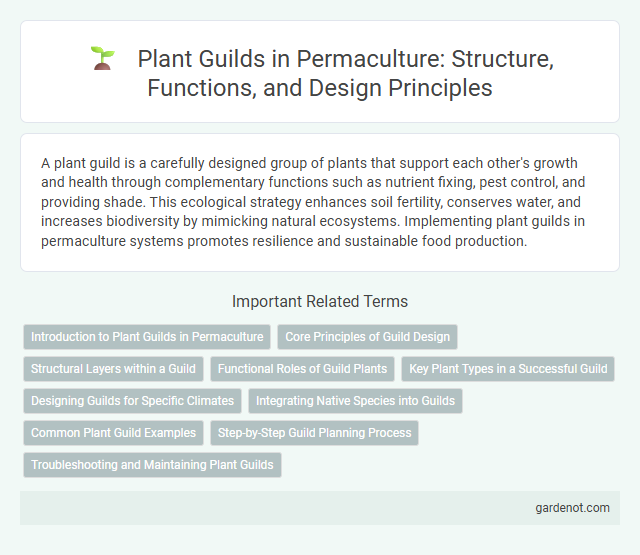A plant guild is a carefully designed group of plants that support each other's growth and health through complementary functions such as nutrient fixing, pest control, and providing shade. This ecological strategy enhances soil fertility, conserves water, and increases biodiversity by mimicking natural ecosystems. Implementing plant guilds in permaculture systems promotes resilience and sustainable food production.
Introduction to Plant Guilds in Permaculture
Plant guilds in permaculture are strategic groupings of plants that support each other's growth, health, and productivity through complementary functions. These combinations typically include nitrogen fixers, dynamic accumulators, ground covers, and pollinator attractors, creating a self-sustaining ecosystem that enhances soil fertility and pest resistance. By mimicking natural forest patterns, plant guilds optimize resource use and promote biodiversity, leading to resilient and productive garden systems.
Core Principles of Guild Design
Plant guilds in permaculture are designed around key principles such as maximizing biodiversity, optimizing resource use, and enhancing mutual support among species. Central elements include selecting complementary plants that fulfill diverse roles like nutrient fixing, pest repelling, and structural support. These guilds create resilient ecosystems that improve soil health, conserve water, and increase overall productivity through symbiotic relationships.
Structural Layers within a Guild
Plant guilds in permaculture consist of multiple structural layers that mimic natural ecosystems, including canopy trees, understory trees, shrubs, herbaceous plants, ground covers, root crops, and vines. These layers maximize space efficiency, enhance biodiversity, improve soil health, and promote nutrient cycling, creating a resilient and self-sustaining environment. Strategic layering supports complementary plant interactions, such as nitrogen fixation, pest control, and moisture retention, optimizing overall guild productivity.
Functional Roles of Guild Plants
Plant guilds in permaculture consist of species that fulfill specific functional roles such as nitrogen fixation, nutrient accumulation, pest repellence, ground cover, and structural support. Nitrogen-fixing plants, like legumes, enrich the soil by converting atmospheric nitrogen, while dynamic accumulators, such as comfrey, draw up minerals from deep soil layers to improve fertility. Pest-repellent plants like marigold help deter harmful insects, and ground covers prevent erosion and suppress weeds, creating a resilient and self-sustaining ecosystem.
Key Plant Types in a Successful Guild
A successful plant guild in permaculture relies on key plant types such as nitrogen-fixers, dynamic accumulators, ground covers, and pollinator attractors to create a balanced and self-sustaining ecosystem. Nitrogen-fixers like clover enrich soil fertility by converting atmospheric nitrogen into usable forms, while dynamic accumulators such as comfrey draw essential nutrients from deep soil layers and make them accessible to surrounding plants. Ground covers reduce erosion and moisture loss, and pollinator attractors like flowering herbs enhance biodiversity and improve fruit set within the guild.
Designing Guilds for Specific Climates
Designing plant guilds for specific climates requires careful selection of species that thrive under local temperature, rainfall, and soil conditions to enhance ecosystem resilience. Combining nitrogen-fixing plants, dynamic accumulators, and ground covers adapted to the climate optimizes nutrient cycling and water retention. Tailoring guild composition to microclimates supports biodiversity and maximizes productivity in permaculture systems.
Integrating Native Species into Guilds
Integrating native species into plant guilds enhances ecosystem resilience by promoting natural pest control, improving soil health, and supporting local pollinators. Native plants are adapted to local climate and soil conditions, reducing water usage and maintenance requirements within permaculture designs. Their inclusion fosters biodiversity and creates balanced, self-sustaining plant communities that mirror natural habitats.
Common Plant Guild Examples
Common plant guild examples in permaculture include the Three Sisters guild, combining corn, beans, and squash to enhance soil fertility and maximize space. Another popular guild is the apple tree guild, integrating nitrogen-fixing plants like clover, dynamic accumulators such as comfrey, and pest-repelling herbs like garlic to support fruit production. These guilds demonstrate synergistic relationships that improve ecosystem health, increase biodiversity, and boost overall yield in sustainable gardening systems.
Step-by-Step Guild Planning Process
Define the desired functions and key species, considering nitrogen fixers, nutrient accumulators, and pollinator attractors. Arrange plants by height, root depth, and growth habit to maximize space and resource use efficiently. Monitor interactions regularly to adjust planting schemes and enhance guild resilience over time.
Troubleshooting and Maintaining Plant Guilds
Effective troubleshooting of plant guilds involves regularly monitoring plant health and identifying signs of nutrient deficiencies, pest infestations, or poor growth patterns. Implementing companion planting principles and adjusting soil conditions can prevent common issues, such as competition for resources or allelopathy effects. Regular maintenance practices like mulching, pruning, and rotating plants support resilience and biodiversity within the guild.
Plant guild Infographic

 gardenot.com
gardenot.com